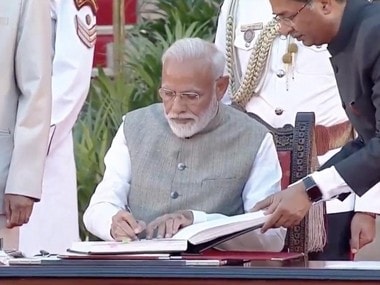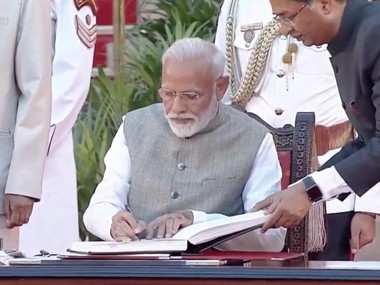There is a curious romance to power, especially power freshly consolidated, and the hubris it casts in the minds of those who wield it. Prime Minister Narendra Modi’s recent address to first-time Members of the Parliament (MP) and MPs of the National Democratic Alliance (NDA) in general offers an illustrative example, replete as it was in contemptuous images of contemporary media and its supposedly endemic negativity. [caption id=“attachment_6729831” align=“alignleft” width=“380”]
 Prime Minister Narendra Modi during the oath-taking ceremony at Rahstrapati Bahvan. Twitter@BJP4India[/caption]
In a piece
following precisely the interpretation that the speaker would have intended, Modi’s vituperative, if not unseemly, words are held as a clarion call to the Indian media to abandon its pursuit of sensationalism and subjectivity by wearing, at long last, the mantle of the fourth estate as democracy’s most critical and durable watchdog. It is difficult to disagree with the maudlin appeal of the sentiment. Since the brisk incursion of private hands into the journalistic medium, the media has reached unexplored, even unseen quarters of the nation’s democracy and recovered experiences that would otherwise have remained obscured. It has taken more people into a conversation than would otherwise have been possible, broadening the range of who and whose experience can participate in the public. Social media, which, the Firstpost piece tells us, was not the object of Modi’s disparagement, has democratised this ‘peopling’ still further. It is equally true, however, that this reaching has come at an onerous cost – financed, by and large, by templates of viewership and readership, the media has also been all too happy to give into brazen sensationalism, crafting acrimonious issues where none existed and more often than not, obscuring matters most worthy and most desperate for public attention. After the privatisation, the governments were able to erase its direct presence in the working of the media, but they use the mass communication that private media offers to clever political purpose. The ills of the media may indeed be many, but given the rich plurality of public opinion, who is to arrogate to herself the right to mediate what objective and subjective coverages are? Indeed, there is a delicious irony when this is done by Modi or, for that matter, votaries of his government and his party – ignoring, for now, the perilous blurring of any difference between the two. Since 2013 when Modi’s first prime ministerial campaign took a certain shape, it has been well-known, even if scarcely acknowledged, that Modi’s ruthless electoral machinery is, for lack of a better term, well-oiled. While oppositional formations, both party-based and otherwise, have faced habitual tax censures, the media did not need even tacit threat. Although many of those were also forthcoming in the deeply troubling events that, for instance, weakened NDTV and created Republic TV, to learn which line to tread and which line to refuse to toe. Throughout his richly-decorated campaign this year, Modi had at his easy command not only a full channel devoted to his campaigning, but also disproportionate coverage, enthusiastic support from most quarters of the media, and interviews featuring avowedly ‘candid,’ ‘apolitical’ questions unbecoming of watchdogs. While one can imagine that many would like to know how Modi eats his mangoes and whether he keeps a batua, to think, in this acknowledgement, that there is something rotten in the media that the prime minister’s criticism can help remedy is perniciously misleading. By no means, of course, is this a defence of the Congress or its equivalently ill-willed UPA governments – it is, after all, from them that the BJP borrows many of its tricks and machinations. But any criticism of contemporary media’s deplorable affinity towards sensationalism cannot stop at former governments and other parties. In its bitterly fought state and national campaigns, the BJP has repeatedly turned a sentence into a sensation – the cases of Mani Shankar Aiyar’s neech remark and more recently, Sam Pitroda’s evidently distasteful words are salutary. Decrying sensationalism, then, demands not just a clarion call to the media, but honest, maximally unbiased introspection. The prime minister’s criticism of the state of the media rests on a hollow basis, for the media is a problem only when it is critical. Despite repeated onslaught in the forms of tax censures and exorbitant defamation suits, a pocket of dissent and criticism, however, fractured and far between, has evidently survived. It appears in many guises – the purveyor of negativity, the ‘presstitutes,’ and more succinctly,
the Khan Market gang
. Such an introspection as afore-suggested would tell us that if the media is to have a future at all, it will have to be in independent-minded individuals and media organisations that keep the government – any government – on its toes. This was felt most dearly, as
Asad Zaidi explains eloquently
, “when the widely felt need for free and independent broadcast media (free from and independent of government control) was systematically confused with and led to the rise of, the privatised and corporatized electronic media.” It is to this frustrated radical desire that the media, perhaps when all else is devastated, will have to turn towards.
Prime Minister Narendra Modi during the oath-taking ceremony at Rahstrapati Bahvan. Twitter@BJP4India[/caption]
In a piece
following precisely the interpretation that the speaker would have intended, Modi’s vituperative, if not unseemly, words are held as a clarion call to the Indian media to abandon its pursuit of sensationalism and subjectivity by wearing, at long last, the mantle of the fourth estate as democracy’s most critical and durable watchdog. It is difficult to disagree with the maudlin appeal of the sentiment. Since the brisk incursion of private hands into the journalistic medium, the media has reached unexplored, even unseen quarters of the nation’s democracy and recovered experiences that would otherwise have remained obscured. It has taken more people into a conversation than would otherwise have been possible, broadening the range of who and whose experience can participate in the public. Social media, which, the Firstpost piece tells us, was not the object of Modi’s disparagement, has democratised this ‘peopling’ still further. It is equally true, however, that this reaching has come at an onerous cost – financed, by and large, by templates of viewership and readership, the media has also been all too happy to give into brazen sensationalism, crafting acrimonious issues where none existed and more often than not, obscuring matters most worthy and most desperate for public attention. After the privatisation, the governments were able to erase its direct presence in the working of the media, but they use the mass communication that private media offers to clever political purpose. The ills of the media may indeed be many, but given the rich plurality of public opinion, who is to arrogate to herself the right to mediate what objective and subjective coverages are? Indeed, there is a delicious irony when this is done by Modi or, for that matter, votaries of his government and his party – ignoring, for now, the perilous blurring of any difference between the two. Since 2013 when Modi’s first prime ministerial campaign took a certain shape, it has been well-known, even if scarcely acknowledged, that Modi’s ruthless electoral machinery is, for lack of a better term, well-oiled. While oppositional formations, both party-based and otherwise, have faced habitual tax censures, the media did not need even tacit threat. Although many of those were also forthcoming in the deeply troubling events that, for instance, weakened NDTV and created Republic TV, to learn which line to tread and which line to refuse to toe. Throughout his richly-decorated campaign this year, Modi had at his easy command not only a full channel devoted to his campaigning, but also disproportionate coverage, enthusiastic support from most quarters of the media, and interviews featuring avowedly ‘candid,’ ‘apolitical’ questions unbecoming of watchdogs. While one can imagine that many would like to know how Modi eats his mangoes and whether he keeps a batua, to think, in this acknowledgement, that there is something rotten in the media that the prime minister’s criticism can help remedy is perniciously misleading. By no means, of course, is this a defence of the Congress or its equivalently ill-willed UPA governments – it is, after all, from them that the BJP borrows many of its tricks and machinations. But any criticism of contemporary media’s deplorable affinity towards sensationalism cannot stop at former governments and other parties. In its bitterly fought state and national campaigns, the BJP has repeatedly turned a sentence into a sensation – the cases of Mani Shankar Aiyar’s neech remark and more recently, Sam Pitroda’s evidently distasteful words are salutary. Decrying sensationalism, then, demands not just a clarion call to the media, but honest, maximally unbiased introspection. The prime minister’s criticism of the state of the media rests on a hollow basis, for the media is a problem only when it is critical. Despite repeated onslaught in the forms of tax censures and exorbitant defamation suits, a pocket of dissent and criticism, however, fractured and far between, has evidently survived. It appears in many guises – the purveyor of negativity, the ‘presstitutes,’ and more succinctly,
the Khan Market gang
. Such an introspection as afore-suggested would tell us that if the media is to have a future at all, it will have to be in independent-minded individuals and media organisations that keep the government – any government – on its toes. This was felt most dearly, as
Asad Zaidi explains eloquently
, “when the widely felt need for free and independent broadcast media (free from and independent of government control) was systematically confused with and led to the rise of, the privatised and corporatized electronic media.” It is to this frustrated radical desire that the media, perhaps when all else is devastated, will have to turn towards.
Hidden within Narendra Modi’s ‘masterclass’ to first-time MPs is a strong critique not just of the state of India’s media, but of dissent itself
Kartik Maini
• May 31, 2019, 13:25:36 IST
The prime minister’s criticism of the state of the media rests on a hollow basis, for the media is a problem only when it is critical.
Advertisement
)
End of Article